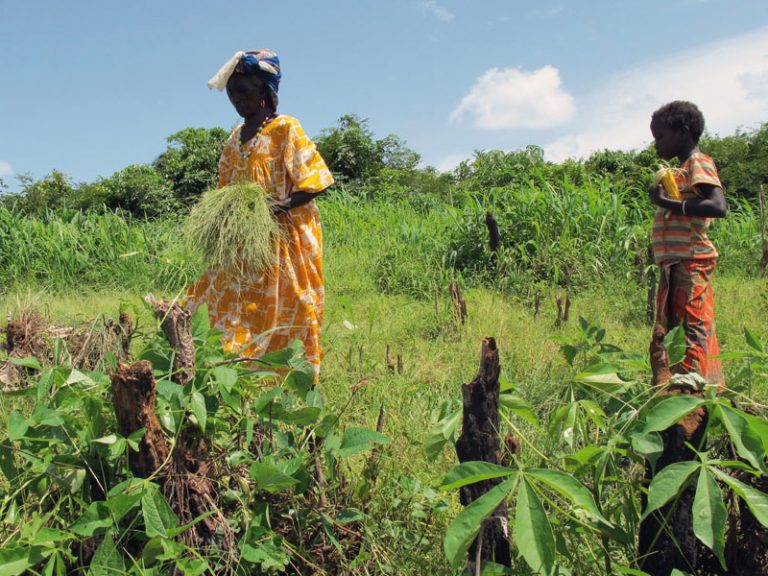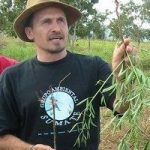For sustainable agriculture in arid and semiarid West African regions
Rethinking management of agricultural and natural systems through ecological engineering
Arid and semiarid West African regions are characterized by heavy environmental constraints that have shaped natural ecosystems and human activities:
low, infrequent, irregular, unpredictable rainfall concentrated within a period of a few months
soils mainly with low organic matter and nutrient content.
Fauna, flora and natural ecosystems—savannas and dry forests—are thus adapted to these more or less prolonged arid conditions. Crop and livestock farming activities, which are highly prevalent in these regions, have also adapted to these constraints over time, primarily to ensure food self-sufficiency, especially through tree-crop-livestock integration. This combination may be noted in farms and villages inhabited by livestock and crop farmers and where both trees and crops grow side-by-side, but also on larger territorial scales via nomadic herding and transhumance practices.
In the current setting of increasing climatic and socioeconomic constraints, dryland farmers have to adapt their practices to meet a dual challenge—produce more to fulfil the substantial food needs of growing populations, while also producing in better and more sustainable ways. Rapid agricultural changes in these areas in favour of more productive, natural resource-efficient and climate-resistant production systems are essential.
Ecological engineering offers new alternatives for the management of agricultural systems that are more tailored to the ever-changing social and environmental necessities in these regions. This requires managing the complexity of agrosystems, while striving to mimic the functioning of natural ecosystems of West African drylands and taking advantage of traditional practices and local know-how resulting from a long process of adaptation to environmental constraints.
Ecological engineering involves “ecosystem management and the design of sustainable, adaptive and multifunctional schemes inspired by or based on mechanisms that govern ecological systems.” The aim is to restore ecosystems disturbed by human activities and to develop sustainable ecosystems of value from both human and ecological standpoints. The intervention strategies are based on the self-organization and self-maintenance capacities of ecosystems. This research jointly involves an ecology-based scientific approach and a practical experimental approach.
Acting on biodiversity
Biodiversity is essential to the productivity of ecosystems and their temporal stability under the impact of external disturbances. Several ecological processes related to biodiversity may be intensified for the benefit of agrosilvopastoral systems:
1. Promoting diversity and soil microorganism activity to benefit plants.For example, two types of microorganisms may contribute to the ecological intensification of agrosilvopastoral systems or to the restoration of degraded land in dryland regions:
Rhizobia, i.e. soil bacteria, when symbiotically associated with legumes, fix gaseous atmospheric nitrogen in a form that can be assimilated by plants.
Mycorrhizal fungi colonize the root system and form, with almost all plants, a symbiotic relationship that enhances the plant’s water and nutrient uptake capacity.
2. Associating and utilizing the mutual benefits of plants. Savannas are environments where various plants coexist and mutually participate in ensuring the resilience of these environments. Agricultural, forestry and livestock farming practices draw on these ecological processes:
– Legume-cereal crop associations, via the atmospheric nitrogen fixation process, enable effective use of environmental resources in low nitrogen input systems.
– Agroforestry practices participate in soil conservation and in the nutrient cycle, increasing the biodiversity, sequestering atmospheric carbon, diversifying income, etc.
– Farmers’ conservation of multipurpose native shrubs in crop fields benefits neighbouring plants, improves the properties and maintains the biological activity of soils while reducing risks to the environment.
– Ecological restoration of dry forests may be passive (e.g. deferred herd grazing), or active (planting local adapted species and mixed species) when the woody plant regeneration potential is low or the soil is degraded.
– Promotion of the biodiversity of local crops—which is currently under tapped—is a way to sustainably address new societal and climatic conditions. Their high genetic diversity adapted to local conditions is the result of farmers’ agricultural and breeding practices (e.g. millet).
Utilizing organic matter and nutrient cycles
The productivity of agrosystems with low chemical input use in dryland regions is primarily based on efficient organic resource management, and in turn on the nutrient and energy flows they induce. It is thus possible to intervene at several levels:
1. Enhancing crop-livestock farming integration to preserve natural resources. Livestock farming, associated with crop farming, enables intensification of the productivity of nutrient-poor soils through the transfer of fertilizing nutrients via livestock. Crop-livestock farming associations may be achieved in three ways at different scales:
– plot: increasing available fodder resources (planting forage trees, etc.)
– farm: reducing nutrient loss (especially nitrogen) due to livestock via biomass recycling (collection of droppings, protected manure pits, etc.)
– territory: managing the landscape to facilitate the presence of livestock and their movements, thus enabling fertility transfers (short fallows, corridors for herd movements, etc.) while reducing the impact of livestock on natural resources, especially woody plants.
2. Restoring the biological activity of soils via specific organic inputs. For example, the effects of rameal chipped wood (RCW) on the soil properties and performances of crop plants are currently being assessed. This technique mimics wooded ecosystems, especially regarding organic inputs in soils and thus their carbon contents.
3. Supplying nutrients to plants locally. Many observations in natural environments revealed that some plants survive by concentrating nutrients around their root system. Zaï—an agricultural practice that mimics ecological processes—is applied in Sahelian regions of Burkina Faso and Niger. This conventional practice involves digging small pits during the dry season to capture rainwater and concentrate nutrients contained in organic matter in the immediate vicinity of the crops. It ensures agricultural production in regions under especially harsh environmental conditions.
Enhancing available water use
Water supplies are limited and irregular in dryland areas. Current management of these supplies—which involves capturing rainwater and surface runoff—could be improved in several ways:
1. Adapting to erratic rainfall or drought risks by focusing on: (i) the organization of the farm and community (farm plot patterns in association with the random rainfall distribution, etc.), and on (ii) cropping techniques to reduce crop water needs (plant choices, weeding, etc.).
2. Preserving water in crop fields by hampering runoff. One example is the application of plant residue to enhance the crop water balance, while favouring production in areas with insufficient rainfall and mitigating hazards due to the random rainfall conditions.
3. Accounting for the essential role of trees regarding soil and water in drylands: enhanced rainwater infiltration in soils, water storage in roots and stems that can be mobilized during droughts, vertical water and nutrient transfers from deep soil horizons, carbon sequestration in soil, etc.
Managing landscapes and associated ecological processes
Ecological crop pest regulation by their natural enemies is one ecosystem service provided by biodiversity. Better pest management could be considered in association with promoting biodiversity at different scales, e.g. from the plant to the landscape:
- Crop field: the characteristics of crop varieties and cropping practices (associations, crop rotations, etc.) are potential levers for farmers.
- Agrosilvopastoral landscape: uncultivated areas are habitats for a wide variety of natural enemies of crop pests. This is a key intervention area. Management of these habitats is a potential lever to hamper crop colonization by pests and promote ecological regulation services. Agroforestry parks are important in this respect.
To be able to effectively disseminate and adopt these innovative or conventional (but improved) ecological engineering practices by crop and livestock farmers in dryland regions, it is essential to take the socioeconomic constraints affecting them into account:
- The right of access to land and water: in a social context where access rights to these resources are not permanent, it is essential that rights—customary or sovereign—ensure long-term access for crop and livestock farmers.
- Agricultural prices: due to the high market volatility, it is crucial to set up agricultural price stabilization mechanisms to stimulate investment.
- Investments: these practices require new investments (funds, labour) and certain operations to immobilize land several years before they become productive. This is a major constraint for family farms with a low investment capacity, without a local banking system, and sometimes a low labour mobilization potential.
- Social and societal issues: long-standing social and societal situations govern (in addition to land access) inheritance, labour and societal organization, the distribution of benefits from crop and livestock farming. All changes in practices shift the established social order. Processes under way in the region related to devolution, decentralization and the founding of farmers’ organizations should also be taken into account.
- Finally, peace and civil security are also obviously crucial for the proper functioning of societies, and hence the dissemination of these practices.




